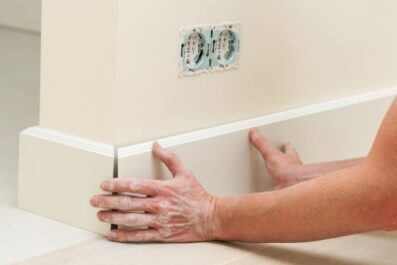Innovative Painting Techniques for a Modern Home Aesthetic

Feeling the urge to completely freshen up your home with a stylish makeover?
Painting is one of the quickest and least expensive ways to transform how your home looks and feels. With just a little know-how and creativity, you can achieve professional-quality results you’re proud to show off.
The problem is:
Most people rely on outdated and uninspired methods — boring flat walls, neutral color palettes, and zero personality. But the painting industry is innovating left and right, and there are some seriously next-level techniques you need to know about.
The good news? Many of these new techniques are surprisingly easy to achieve.
In this complete guide, we’re going to walk you through the most advanced painting methods being used to transform modern homes today. From textured finishes and beyond, you’ll learn exactly how to infuse a fresh contemporary edge into each and every room.
Ready to dig in?
Here’s the quick summary:
- Innovative Painting Techniques Are Transforming Interiors
- Color Drenching: The Ultimate Bold Statement Technique
- Textured Finishes That Wow
- Two-Tone Walls: A Designer Favorite
- Limewash & Natural Plaster Effects
Innovative Painting Techniques Are Transforming Interiors
The exciting thing about new painting techniques is they’re more than just a passing fad. These techniques are all about creating spaces that express your personality while adding real value to your home.
The home painting industry is huge, with the US residential market alone estimated to hit $24.4 billion in 2024 and showing no signs of slowing down. Homeowners are waking up to the fact that innovative painting isn’t just cosmetic — it’s a lifestyle upgrade.
Painting is the single easiest and least expensive home improvement you can do to change how a space looks and feels. It instantly creates visual interest, adds dimension, and makes a house feel more like “home”. Gone are the days of “builder beige” — homeowners are embracing personality and originality.
Advanced techniques are also solving old decorating challenges. Textured finishes are perfect for hiding wall imperfections. Dramatic color blocking can make small rooms feel larger or cozy rooms more intimate.
Color Drenching: The Ultimate Bold Statement Technique
Color drenching is the big new trend sweeping the design world.
Here’s what you need to know: Forget painting just your walls one color and leaving trim white — color drenching involves painting every wall surface, including ceilings, trim, doors, and sometimes even floors in carefully chosen shades of the same color family. This creates an immersive cocoon-like effect that is dramatic and intentional.
Why is this technique working so well right now? It’s because it eliminates all those visual interruptions that used to break up a room. Walls, ceiling, trim, doors — when everything is in complementary shades of the same hue, it makes a space feel so much larger and harmonious. Navy walls with royal blue trim adds depth. Eggplant walls with orchid accents equals sophistication.
The key to pulling off this bold technique successfully is to choose colors with slight variations. You don’t want the exact same shade everywhere or it looks flat and lifeless. Choose different tones of the same color to create layers and dimension.
Color drenching works particularly well in smaller rooms like powder rooms or home offices where you want to make a big impact.
Textured Finishes That Wow
Flat paint on walls is so 2005. Textured finishes are where it’s at right now.
We’re talking Venetian plaster that looks like marble but is super sophisticated. Limewash that creates a chalky, organic texture. Suede finishes that feel like velvet on your walls. Velvet-like finishes are the next frontier in wall textures.
These aren’t your grandma’s textured walls with popcorn ceilings and chunky paint. Textured finishes are a big part of the modern farmhouse movement but are also super popular in sleek urban homes. The key is texture with subtlety that adds interest without overwhelming a space. The way light dances across a textured surface is dimensional magic you simply can’t get with flat paint.
Textured finishes also are brilliant for covering up little wall imperfections if your walls aren’t perfectly smooth. Textured paint can be much more forgiving than flat paint so it’s great for older homes or spaces where you don’t want to spend a ton on prep work.
Applying textured finishes like these takes skill so that’s where professional painters come in — they know how to apply the paint evenly and with the exact effect you’re after so you don’t end up with a DIY disaster.
Two-Tone Walls: A Designer Favorite
Two-tone walls are back but in a fresh new way.
We’re not talking old-school chair rails bisecting walls horizontally. Now we’re seeing designers creating big bold geometric shapes, diagonal splits, and interesting color blocking on walls to add visual intrigue.
Two-tone walls are perfect for plain walls that lack architectural detail. A boring bedroom with standard drywall suddenly becomes interesting when the bottom third is painted one color and the top two-thirds another.
You can play it cool and go two shades of the same color for a very grown-up subtle effect. Or you can go wild with contrasting colors and patterns for a look that pops with drama and energy. Dark gray below with crisp white above gives a modern gallery vibe. Warm terracotta and cream creates a Mediterranean look.
Placement is key here. A one-third rule dividing the wall and stretching up towards the ceiling can make rooms look taller. Horizontal two-tone walls at eye level can make narrow rooms look wider.
Limewash & Natural Plaster Effects
Limewashing is having a major moment right now as homeowners look for more organic textured alternatives to paint.
Limewash gives walls a soft cloud-like texture with beautiful subtle color variations that create dimension. Unlike regular paint that sits on top of walls, limewash actually penetrates the surface creating a natural patina that will mellow and change over time.
Homeowners love limewash now because it’s the ultimate “bought back from a villa in Europe” look. It gives spaces a lived-in but carefully curated feel instead of looking like it was just painted yesterday. The subtle gradations in tone and color create movement and visual interest that is perfectly modern.
Natural plaster effects are a similar category that are also growing in popularity. Anything that offers warmth and authenticity is gold these days. Natural finishes go beautifully in modern spaces because they add organic texture while still maintaining those crisp clean lines.
Application process for limewash and plaster effects is a skill and a bit of patience. We get it, 70% of homeowners who have hired professionals for painting say they would hire again, and specialized finishes like limewash are where that skill level is most appreciated.
Limewash also fits in with the increased environmental awareness happening. Limewash is naturally breathable and made from limestone so it’s an eco-friendly option that improves indoor air quality over traditional paint.
Wrapping Things Up
Innovative painting techniques are changing how people approach home interiors and decor. From dramatic color drenching to sophisticated textured finishes, these advanced methods are providing endless opportunities for creating spaces that are truly contemporary, personal, and stunning.
The important part with any of these techniques is planning ahead. Start by assessing which rooms in your home are good candidates for a more adventurous approach. Think about your lifestyle, existing furniture, and the vibe you want to create.
Remember that painting is one of the easiest home improvements to reverse. If you get a little carried away with a bold new technique and decide you don’t love it, it’s no big deal — just paint over it! This makes painting the ideal way to experiment with modern design trends without fear of making permanent mistakes.
Start small if you’re new to these techniques — try a color drench on a powder room before you commit to a big room. Test out textured finishes on an accent wall and see how you like the look. Ultimately your home should reflect who you are and how you want to live.




